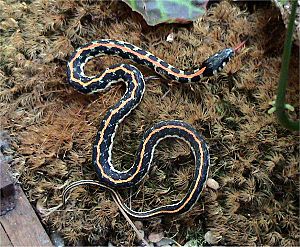Blackneck garter snake facts for kids
Quick facts for kids Blackneck garter snake |
|
|---|---|
 |
|
| Eastern black-necked garter snake (Thamnophis cyrtopsis ocellatus) | |
| Conservation status | |
| Scientific classification | |
| Genus: |
Thamnophis
|
| Species: |
cyrtopsis
|
The blackneck garter snake is a type of garter snake that lives in the southwestern United States, Mexico, and Guatemala. You might hear it called the blackneck garter snake. These snakes can be found in many different places, but they often like to be near water.
Contents
About Blackneck Garter Snakes
There are different types of blackneck garter snakes, called subspecies. Two of the most well-known types are the Western blackneck garter snake and the Eastern blackneck garter snake.
Western Blackneck Garter Snake
Thamnophis cyrtopsis cyrtopsis
The Western blackneck garter snake can grow to be about 42 inches (107 cm) long. It has a dark olive color with a bright orange-yellow stripe down its back. Its belly is usually cream or light gray. This snake loves water! It lives near rivers, swims well, and eats small fish and tadpoles.
Eastern Blackneck Garter Snake
Thamnophis cyrtopsis ocellatus
The Eastern blackneck garter snake is smaller than its western cousin, usually less than 20 inches (51 cm) long. It's often found on dry land, but always close to water. This snake has three light stripes on its dark body, with orange and orange-yellow colors spread throughout.
Where Do They Live?
Blackneck garter snakes can be found in places like southeastern and central Arizona. They also live in other parts of the southwestern United States, Mexico, and Guatemala.
Their Homes
These snakes like to live near water in many different environments. You can find them in desert areas with shrubs, grassy fields, bushy chaparral, and even in woodlands.
How They Behave
Blackneck garter snakes are usually active during the day and around sunset. Sometimes, they are even active at night! They take a long nap, called hibernation, from late fall to winter. They usually find a mate in late spring or summer.
What Do They Eat?
These snakes are good hunters. They look for food in rivers, eating small fish, frogs, salamanders, and even other snakes. They also enjoy eating invertebrates, like earthworms.
See also
 In Spanish: Culebra lineada de bosque para niños
In Spanish: Culebra lineada de bosque para niños


